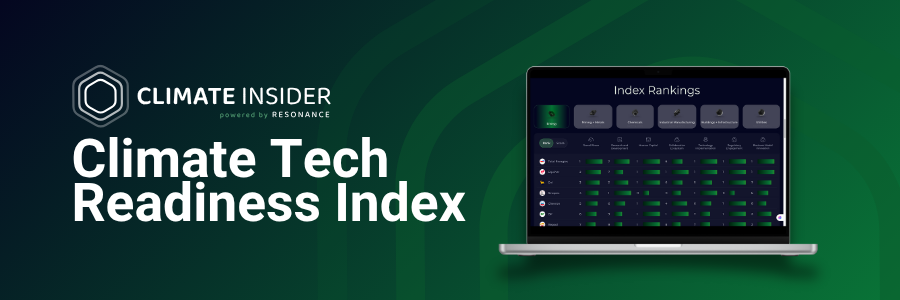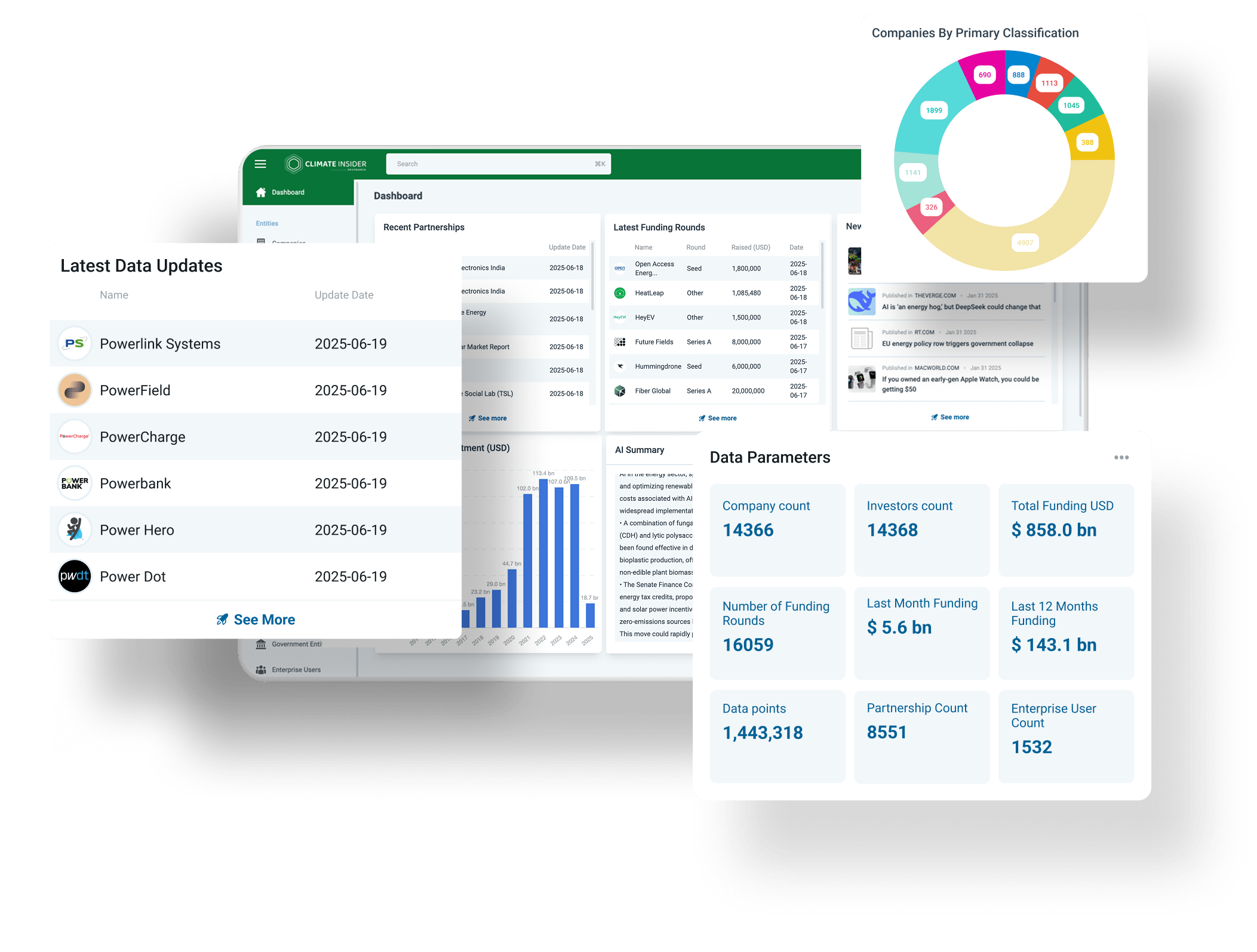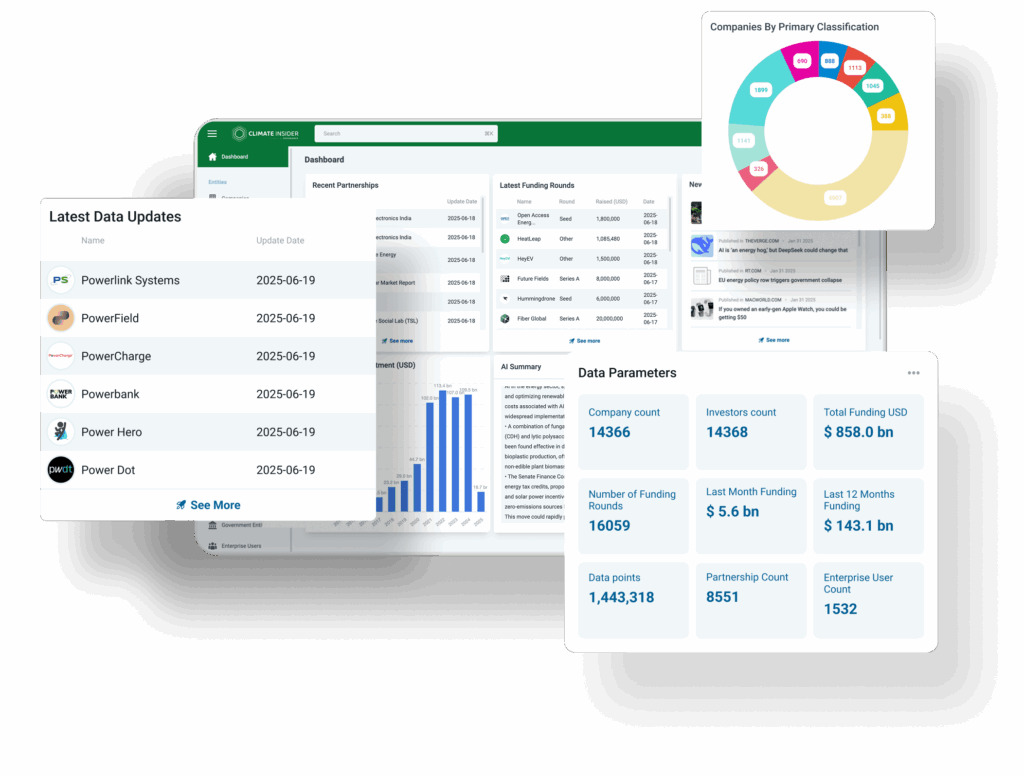Southeast Asia, a region characterized by its diverse economies and environmental challenges, stands at a critical juncture in the global effort to combat climate change.
The region’s rapid economic growth has been accompanied by increasing energy demands and environmental stress, making it imperative to address climate change effectively. Southeast Asia’s vulnerability to climate impacts, rising sea levels, extreme weather events, and air pollution, underscores the urgent need for innovative climate solutions.
Despite infrastructure and regulatory challenges, Southeast Asia is emerging as a new frontier for climate tech innovation and investment. The region is becoming a hub for advances in renewable energy, energy efficiency, and carbon management. As governments increase their support and the market for sustainable technologies grows, investors from Europe and North America are increasingly seeing Southeast Asia as a prime destination for climate tech investments.
Our analysis aims to outline climate tech trends and investment opportunities across Southeast Asia. We’ll explore the region’s climate tech ecosystem to uncover the factors driving its growth.

From technologies changing traditional sectors to government policies encouraging development, this article will guide you through Southeast Asia’s climate tech landscape. We’ll discuss why investors are focusing on this region in the context of addressing climate change.
What Investors Need to Know About Climate Tech in Southeast Asia
The climate tech landscape in Southeast Asia shows an upward investment trend, but challenges persist. According to the Asian Development Bank (ADB), Southeast Asia received $27.8 billion in climate finance between 2018 and 2019.
This sum represented a mere 5% of the total climate finance flowing into Asia and the Pacific during this period.
Nevertheless, the region has experienced significant growth in renewable energy investments, which comprised 84% of total climate finance in Southeast Asia during this period. A closer examination reveals that most of this funding was directed towards mitigation projects, particularly in the clean energy and transportation sectors, underscoring the region’s focus on reducing carbon emissions.
In comparison, adaptation finance lags behind, with only 12% of climate finance being directed towards adaptive measures. This imbalance is worrying for a region highly vulnerable to climate risks like sea-level rise and typhoons. The stark disparity between mitigation and adaptation financing highlights a critical gap. Investors can help bridge this gap by focusing on projects that enhance climate resilience, particularly in areas such as water management and disaster risk reduction.
Key Climate Tech Innovations
Renewable Energy
Renewable energy is the cornerstone of Southeast Asia’s climate tech revolution. In recent years, the region has made impressive strides in solar, wind, and hydropower.
For instance, Vietnam has become a leader in solar energy, with its solar capacity skyrocketing to 16.5 GW by 2020, largely due to its favorable government policies, including well-structured feed-in tariffs (FiTs). These FiTs were introduced in 2017 and set at 9.35 US cents per kWh, which attracted significant foreign and domestic investment in solar projects. This competitive rate incentivized rapid solar capacity expansion by guaranteeing attractive returns for investors over a 20-year period. As a result, Vietnam became one of Southeast Asia’s fastest-growing solar markets, making it a prime example of how government policy can accelerate renewable energy adoption
The majority of climate finance in Southeast Asia is funneled into renewable energy projects, especially solar photovoltaic (PV) and wind power, as these technologies are seen as more mature and scalable. One of the largest solar PV projects is the Dau Tieng Solar Power Complex in Vietnam, which is currently the largest solar farm in Southeast Asia with a capacity of 600 MW. Similarly, the Ninh Thuan Solar Farm also in Vietnam, has a capacity of 450 MW, contributing significantly to the country’s renewable energy capacity.
In the wind power sector, the Binh Thuan Wind Farm, located along Vietnam’s coastal areas, is among the largest in the region with a capacity of 120 MW. Thailand’s Theppana Wind Farm, with a capacity of 7.5 MW, also exemplifies the growing investment in wind energy across the region. Hydropower remains significant, especially in countries like Laos, where 90% of electricity is generated through hydropower, although these projects are increasingly scrutinized for their environmental impacts.
Energy Efficiency
Innovations in energy efficiency are also gaining ground, particularly in urban centers like Singapore, where green building initiatives are reducing energy consumption in commercial and residential spaces. Singapore’s Building and Construction Authority has set ambitious targets, aiming for 80% of buildings to be Green Mark-certified by 2030. Notable examples include Marina Bay Sands, a mixed-use development known for its sustainable design, and the National Gallery Singapore, which incorporates energy-efficient systems like rainwater harvesting and solar shading. The CapitaGreen building is another premier example, featuring rooftop greenery, an energy-efficient façade, and advanced ventilation systems, which reduce its overall energy consumption by 26%. These high-performance green buildings showcase how Singapore is leading the region in adopting cutting-edge energy efficiency solutions.
In Southeast Asia, smart grids and energy management systems are increasingly being deployed, enhancing energy distribution and reducing wastage. However, compared to the substantial investments in renewable energy, energy efficiency receives significantly less funding. According to the Asian Development Bank’s Climate Finance Landscape Report, mitigation finance for renewable energy in Asia and the Pacific reached $255.6 billion in 2018–2019, accounting for 54% of total climate finance, while energy efficiency investments were notably smaller, comprising only a fraction of overall climate financing. This disparity highlights the untapped potential for investments in energy-efficient technologies, such as smart appliances and industrial energy systems.
Carbon Management
Carbon management technologies are increasingly gaining attention in Southeast Asia, driven by the region’s Nationally Determined Contributions (NDCs) under the Paris Agreement. For instance, Indonesia has committed to reducing its emissions by 29% by 2030 under its updated NDCs, with a focus on sectors like forestry, energy, and industrial processes. Malaysia, another significant emitter in the region, has pledged a 45% reduction in emissions intensity of GDP by 2030 compared to 2005 levels. These ambitious targets underscore the growing importance of carbon capture and storage (CCS) technologies in these countries.
In Indonesia, CCS is gaining momentum, particularly in the energy sector. The Asian Development Bank highlights the potential for CCS technologies to play a critical role in meeting Indonesia’s emission reduction goals. Specifically, the country is targeting the capture of approximately 291 million tons of CO2 by 2030, focusing on emissions from power plants and industrial sources. In Malaysia, CCS projects are also in the pilot phase, with key collaborations between Petronas and the ADB exploring the feasibility of large-scale CO2 storage.
Specific CCS solutions include Enhanced Oil Recovery (EOR) projects, where captured CO2 is injected into oil fields to increase output, a method currently being explored in Malaysia. Direct Air Capture (DAC) technologies are less developed in Southeast Asia but represent a potential future avenue for large-scale carbon removal, particularly as regional governments look to meet their stricter NDC targets.
Additionally, carbon offset programs, such as Indonesia’s forestry-based carbon credits under the REDD+ framework, are attracting international investors. These initiatives aim to offset emissions through sustainable forest management, providing a dual benefit of conserving biodiversity while also contributing to the global carbon market.
Government Policies and Initiatives
National Climate Strategies
Government policies across Southeast Asia are evolving to support climate tech innovations better. Vietnam, for instance, has committed to achieving net-zero emissions by 2050. Indonesia aims to reduce emissions by 29% by 2030, according to its updated Nationally Determined Contributions (NDCs). These commitments are backed by various government incentives—tax breaks, subsidies, and green bonds—designed to attract foreign investment in climate tech.
However, the region’s regulatory frameworks remain fragmented, with investors often struggling to navigate inconsistent policies across countries.
Regional Collaboration
Regional collaboration is driving climate tech development in Southeast Asia. The ASEAN Centre for Energy is spearheading cross-border initiatives like the ASEAN Power Grid to boost energy security and promote renewable energy adoption. However, foreign investors face challenges due to regulatory hurdles, particularly in energy market structures and local content requirements. To scale climate tech innovations effectively, it’s crucial to streamline these regulations and create more consistent policies across the region.
Investment and Market Trends
Funding Landscape
The funding landscape for climate tech in Southeast Asia is becoming increasingly diverse, driven by a combination of public and private capital. Between 2018 and 2019, national development finance institutions (DFIs) across Asia contributed over $351.8 billion to public climate finance, with Southeast Asia receiving a significant share for renewable energy projects. Major players in this space include the Asian Development Bank (ADB) and Temasek Holdings, which are leading large-scale funding efforts for clean energy and sustainable infrastructure projects. Additionally, Breakthrough Energy Ventures and BlackRock are emerging as key private investors in the region, particularly in clean energy and carbon management startups.
Experts estimate that Southeast Asia will require an additional $2.5 trillion in climate investments by 2030 to reach net-zero emissions, with the majority of this funding needed for renewable energy expansion and energy efficiency projects. Private investment, while smaller than public capital flows, has shown remarkable growth. Venture capital and private equity firms are increasingly recognizing the long-term value of climate tech startups. Government-backed green bonds are also gaining traction, with countries like Indonesia and Malaysia issuing green bonds to attract international capital into climate projects. This growing diversity in funding sources highlights the region’s potential to attract both public and private capital as it moves toward its net-zero goals.
Market Growth and Opportunities
Key market trends indicate that the clean energy sector will continue to dominate climate tech investment in Southeast Asia. The region is poised for significant growth, with the climate tech market in Southeast Asia and India estimated at $102 billion in 2023 and projected to surge to $350 billion by 2030, representing a compound annual growth rate (CAGR) of about 20%. This rapid expansion is being driven by investments in renewable energy, electric mobility, and agriculture tech, reflecting the increasing demand for sustainable solutions across the region.
- Investment trends: In 2022, Southeast Asia and India accounted for approximately 7% of the $70 billion invested globally in climate tech. Southeast Asia alone raised $725 million in climate tech venture capital (VC) funding, with Indonesia leading the pack, accounting for 67.4% of this total. Renewable energy is the largest recipient of these investments, with $7.72 billion in funding poured into the sector, and solar energy identified as a key driver of the region’s energy transition.
- Carbon market growth: Southeast Asia’s carbon market is also expected to grow substantially. The global carbon market is projected to increase from $3 billion today to $33 billion by 2030, with India and Southeast Asia accounting for a significant portion of this expansion. In fact, offset demand in the region is anticipated to reach $10 billion by 2030, creating new opportunities for investors in carbon management technologies.
- Electric vehicle (EV) market: Southeast Asia’s EV sector is experiencing a remarkable boom, particularly in two-wheeler and four-wheeler production. Electric two-wheeler sales are expected to grow at a 53% CAGR, while four-wheeler production is set to expand at 45% CAGR through 2030. Countries like Thailand are positioning themselves as EV manufacturing hubs, with plans to produce 30% of total vehicle output as electric vehicles by 2035.
- Agriculture and food sector: The agricultural tech sector in Southeast Asia is another area of significant growth potential, with an underserved market estimated at $50 billion as of 2022. In fact, 42% of the top 50 climate tech startups in the region operate within the agriculture and food subsector, reflecting the increasing demand for sustainable farming practices and technology-driven solutions.
While the clean energy sector remains dominant, growing opportunities in energy efficiency and carbon management technologies are emerging as governments across Southeast Asia tighten their emission regulations. The region’s relatively high growth potential, coupled with its abundance of natural resources and favorable policy environment, makes it an attractive destination for investors, particularly when compared to more mature markets in Europe and North America. However, risks such as regulatory uncertainty and currency volatility should be factored into any investment strategy to ensure long-term success.
Case Studies
Success Stories
Sunseap Group, based in Singapore, shines as a climate tech success story in Southeast Asia. The company has led the way in solar energy projects throughout the region, introducing innovative business models such as solar leasing. This approach has made clean energy more accessible to both businesses and households. In Vietnam, Sunseap’s projects have played a key role in the country’s swift ascent as a solar energy leader. This success illustrates how foreign investment, bolstered by supportive government policies, can propel climate tech forward.
Lessons Learned – The Unique Advantages of Southeast Asia
For Western companies entering Southeast Asia’s climate tech market, cultural awareness and relationship-building are crucial. Business practices in the region often prioritize personal connections and trust, which significantly influence negotiations and partnerships. Southeast Asia offers several distinct advantages over home markets, creating strong opportunities for investors:
- Significant market growth potential: Southeast Asia’s climate tech market is projected to grow rapidly, driven by the region’s increasing demand for renewable energy and sustainable solutions. According to the Asian Development Bank, Southeast Asia received $27.8 billion in climate finance between 2018–2019, with renewable energy being a key focus. This represents a small portion of the $519.9 billion total climate finance in Asia-Pacific, highlighting potential for expansion.
- Rich natural resources for nature-based solutions: The region hosts 15% of the world’s tropical forests, offering unique opportunities for carbon offset programs. For instance, Indonesia’s forestry-based carbon credits under the REDD+ framework are attracting international investments, positioning Southeast Asia as a leader in carbon offset supply by 2030.
- Emerging carbon market: Governments in Southeast Asia are moving towards the creation of a uniform carbon trading system. Indonesia and Malaysia are already piloting projects, with the total global carbon market expected to grow from $3 billion to $33 billion by 2030.
- Opportunities in agriculture technology: The agricultural technology market is an underserved $50 billion sector in Southeast Asia, driven by policy tailwinds that support productivity improvements and technology adoption. This includes sustainable farming practices and smart agriculture solutions to meet food security challenges.
- Rising climate tech startup ecosystem: The number of climate tech startups in Southeast Asia has tripled between 2017 and 2022. These startups are addressing a wide range of ecosystem challenges, from renewable energy to waste management, and attracting increasing venture capital.
- Focus on circular economy solutions: Companies across the region are focusing on creating circular supply chains to reduce waste, particularly in the food, manufacturing, and construction sectors. This push towards sustainability is backed by government initiatives aimed at reducing environmental impacts and promoting resource efficiency.
However, potential pitfalls include navigating complex regulatory landscapes, which can vary significantly between countries. Additionally, Western companies often underestimate the importance of local partnerships. Building strong relationships with local stakeholders and understanding the intricacies of each market are essential for long-term success.
Future Outlook
Technological Advancements
Looking ahead, advancements in various climate technologies are expected to play a transformative role in Southeast Asia’s climate tech sector. One of the most promising areas is electric vehicle (EV) technology. Companies like Singapore-based Charge+ are already making strides in this space by developing slim AC EV chargers with dual charging points, specifically designed for space-constrained urban environments. As governments in the region, such as Thailand and Indonesia, aim to boost EV adoption and production, advancements in EV charging infrastructure and battery technology will be critical to achieving these goals.
In the realm of carbon capture and storage (CCS), there is growing interest in carbon capture, utilization, and storage (CCUS) technologies. Several demonstration projects are expected across key industrial sectors, including oil and gas, cement, and steel production. For example, Petronas in Malaysia is piloting a CCS project aimed at capturing industrial emissions, with support from the Asian Development Bank (ADB). These technologies are not only vital for meeting national emissions targets but also for positioning the region as a leader in carbon management.
Green hydrogen production is another area poised for significant growth. Southeast Asia, particularly Indonesia and Malaysia, is well-positioned to develop green hydrogen due to its abundant renewable energy resources. Technological improvements in the production of hydrogen through electrolysis, powered by renewable energy, are anticipated. As China aims to ramp up its hydrogen production by 2060, the technology will likely spill over into Southeast Asia, providing opportunities for regional collaboration.
Lastly, advancements in energy storage systems are set to revolutionize how Southeast Asia manages its growing renewable energy capacity. As energy storage technologies become more advanced, systems with greater capacity and efficiency will enable better integration of intermittent renewable energy sources like solar and wind. Increased investment in these technologies will be key to stabilizing the grid and ensuring consistent energy supply. Companies and governments across the region are beginning to invest in large-scale storage solutions, such as battery energy storage systems (BESS), to support renewable energy deployment.
With these advancements, Southeast Asia could become a testing ground for groundbreaking climate solutions, capitalizing on its abundant renewable energy resources and growing commitment to carbon reduction.
Policy and Market Evolution
Government policies are expected to evolve further, with more stringent emission targets and increased incentives for clean technology adoption.
Market dynamics are also likely to shift as demand for climate tech solutions grows, particularly in sectors like electric mobility and green infrastructure. Investors should keep a close eye on upcoming policy changes and be prepared to adapt their strategies to capitalize on emerging opportunities.
Southeast Asian governments are expected to play a more active role in shaping the future of climate tech. With countries like Indonesia and Vietnam setting ambitious climate goals, policy frameworks will likely evolve to provide greater incentives for green technology adoption, including subsidies, tax benefits, and investment-friendly regulatory changes. For instance, Vietnam’s commitment to reach net-zero emissions by 2050 and Indonesia’s push to reduce emissions by 29% by 2030 signal a policy shift that aligns with global climate targets. As these governments enhance their climate policies, they will likely prioritize renewable energy projects, energy efficiency initiatives, and carbon capture technologies, creating more opportunities for investors.
As Southeast Asian nations become more integrated through regional collaborations—like the ASEAN Power Grid—the market for cross-border renewable energy trade is likely to expand. This expansion will drive further demand for climate tech innovations, creating additional opportunities for investors to explore joint ventures and collaborative projects across the region. However, the pace of these policy shifts will vary by country, requiring investors to remain agile as they navigate evolving regulatory landscapes.
The Climate Tech Investors Summit
The upcoming Climate Tech Investors Summit in New York promises to be a pivotal event for those shaping the future of climate technology. Sponsored by The Climate Tech Coalition and the Altru Investment Network, this exclusive gathering is a must-attend for family offices, institutional investors, and technologists committed to funding impactful climate solutions and driving sector innovation.
Building on last year’s success—which drew 15 family offices, 20 venture capitalists, and over 100 attendees—the event has established itself as a powerful network of changemakers. These industry leaders are mobilizing capital to tackle the planet’s most pressing environmental challenges. This year’s summit will provide an even broader platform for collaboration and insight-sharing, aimed at sparking transformative ideas and investments.
Attendees will engage in interactive roundtable discussions on decarbonization strategies, climate tech entrepreneurship, and breakthrough technologies. The event will showcase top industry figures from firms like Lowercarbon Capital, Breakthrough Energy Ventures, Fifth Wall, and BlackRock, who will share insights on accelerating climate action through private capital. These sessions offer participants a unique opportunity to deepen their understanding of capital’s role in driving climate solutions.
The summit will also provide exclusive networking opportunities, connecting high-net-worth individuals and family offices with cutting-edge climate tech projects. Investors can engage directly with climate tech startups, potentially forming partnerships that could spark the next wave of innovation in Southeast Asia’s climate tech market. With its focus on relationship-building, the event serves as a unique platform for investors to discover promising projects and align their portfolios with global sustainability goals.
As Southeast Asia emerges as a climate tech leader, this summit will offer the insights, partnerships, and action-oriented strategies needed to capitalize on the region’s growing potential. For investors serious about driving change and seeking lucrative opportunities, the Climate Tech Investors Summit is an unmissable event.







